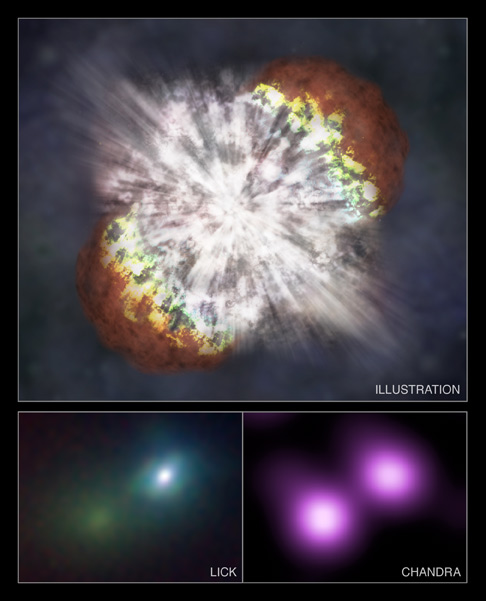
Scientists have detected a stellar explosion that is the brightest and most energetic ever recorded, and which could be the first evidence of a new type of supernova fueled by an antimatter engine.
The "SN 2006gy" explosion occurred in a galaxy 240 million light-years away, called NGC 1260, and was 100 times more energetic than typical supernovas. It was detected in September 2006 using ground-based telescopes and NASA's Chandra X-ray space observatory. It brightened slowly for 70 days, and at its peak emitted more than 50 billion Suns worth of light-shining 10 times brighter than its host galaxy-before dimming slowly. Most supernovas reach peak brightness in days to a few weeks.
"Of all exploding stars ever observed, this was the king," said Alex Filippenko of the University of California, Berkeley, who led ground-based observations of the supernova at Lick Observatory in California and Keck Observatory in Hawaii. "We were astonished to see how bright it got and how long it lasted."
NASA has released an image and animation of what the explosion might have looked like.
The finding, presented today at a NASA press conference and detailed in an upcoming issue of The Astrophysical Journal, provides evidence for a fundamentally different type of supernova explosion that only occurs with the universe's most massive stars.
The monster supernova suggests the first stars that illuminated the universe died in explosive lightshows. "We may have witnessed a modern-day version of how the first generation of the most massive stars ended their lives," Filippenko said.
Astrophysicists also think the supernova could be a preview of what they will see when a massive star in our own galaxy explodes.
Get the Space.com Newsletter
Breaking space news, the latest updates on rocket launches, skywatching events and more!
Going out with a bang
Supernovas are stellar swan songs. They occur when ancient, massive stars do as poet Dylan Thomas advised, that is, to "burn and rage at the close of day," and "rage, rage against the dying of the light."
Most supernovas are the result of stars with 8 to 20 times the mass of our Sun collapsing under their own gravity. Astronomers think something different happened with SN 2006gy, whose star was much bigger--about 150 solar masses.
Stars this massive are extremely rare: Scientists estimate there are only a dozen or so such stars in the Milky Way's stellar population of 400 billion.
Supermassive stars are thought to produce so much gamma-ray light at the end of their lives that some of the radiation is converted into matter and antimatter, mostly electrons and positrons. Antimatter particles have the same mass as ordinary matter but opposite atomic properties such as spin and charge. Gamma radiation is the energy that prevents the outer layers of a star from collapsing; once it starts disappearing, the star's outer layer falls inward, triggering a thermonuclear explosion that destroys the star.
The new findings suggest some of the first stars in the early universe, which were also very massive, went out in spectacular explosions like SN 2006gy, instead of bypassing the supernova stage and collapsing directly into black holes.
"In terms of the effect on the early universe, there's a huge difference between these two possibilities," said study leader Nathan Smith, also of UC Berkeley. "One pollutes the galaxy with large quantities of newly made elements, and the other locks them up forever in a black hole."
Eta Carinae
Scientists think SN 2006gy could be a sign of things to come in our own galaxy. Eta Carinae, the most luminous star in our Milky Way, is located some 7,000 light-years away and seems poised to undergo its own explosion at any moment.
"This could happen tomorrow or it could happen 1,000 years from now," said Mario Livio of the Space Telescope Science Institute in Baltimore, who was not involved in the research.
Eta Carinae is an unstable star currently radiating about 5 million times more energy than our Sun and is undergoing eruptions on its surface that are similar to what scientists think happened on the star that produced SN 2006gy just before it blew.
Despite its relatively close proximity to us, Eta Carinae's death is not likely to pose any significant threat to life on Earth, scientists say.
"I think we can sleep quietly tonight for Eta Car not extinguishing life on Earth," Livio said, "but [SN 2006gy] and all the questions it brings about will keep us awake for quite a while."
- Top 10 Star Mysteries
- Vote Now: The Strangest Things in Space
- VIDEO: The King of Supernovas
Join our Space Forums to keep talking space on the latest missions, night sky and more! And if you have a news tip, correction or comment, let us know at: community@space.com.
Ker Than is a science writer and children's book author who joined Space.com as a Staff Writer from 2005 to 2007. Ker covered astronomy and human spaceflight while at Space.com, including space shuttle launches, and has authored three science books for kids about earthquakes, stars and black holes. Ker's work has also appeared in National Geographic, Nature News, New Scientist and Sky & Telescope, among others. He earned a bachelor's degree in biology from UC Irvine and a master's degree in science journalism from New York University. Ker is currently the Director of Science Communications at Stanford University.









